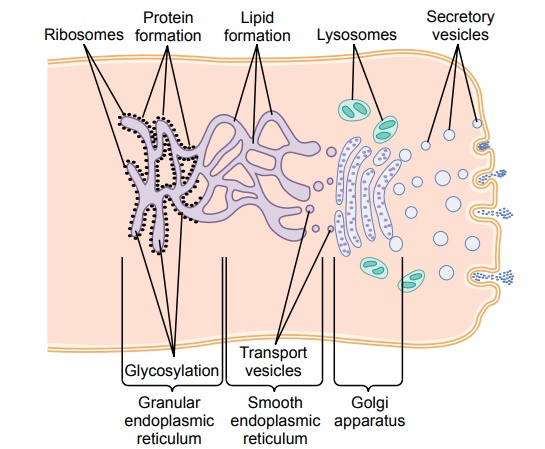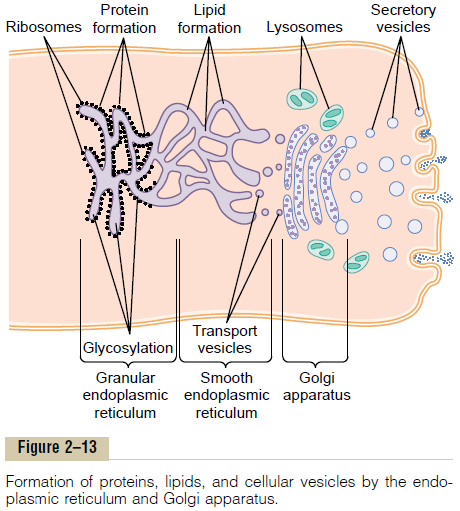Chapter: Medical Physiology: Introduction to Physiology: The Cell and Its Functions
Synthesis and Formation of Cellular Structures by Endoplasmic Reticulum and Golgi Apparatus

Synthesis and Formation of Cellular Structures by Endoplasmic Reticulum and Golgi Apparatus
Specific Functions of the Endoplasmic Reticulum
The extensiveness of the endoplasmic reticulum and the Golgi apparatus in secretory cells has already been emphasized. These structures are formed primarily of lipid bilayer membranes similar to the cell membrane, and their walls are loaded with protein enzymes that catalyze the synthesis of many substances required by the cell.
Most synthesis begins in the endoplasmic reticulum. The products formed there are then passed on to the Golgi apparatus, where they are further processed before being released into the cytoplasm. But first, let us note the specific products that are synthesized in specific portions of the endoplasmic reticulum and the Golgi apparatus.
Proteins Are Formed by the Granular Endoplasmic Reticulum.
The granular portion of the endoplasmic reticulum is characterized by large numbers of ribosomes attached to the outer surfaces of the endoplasmic reticulum membrane. As we discuss, protein mole-cules are synthesized within the structures of the ribo-somes. The ribosomes extrude some of the synthesized protein molecules directly into the cytosol, but they also extrude many more through the wall of the endo-plasmic reticulum to the interior of the endoplasmic vesicles and tubules, that is, into the endoplasmicmatrix.
Synthesis of Lipids by the Smooth Endoplasmic Reticulum.
The endoplasmic reticulum also synthesizes lipids, especially phospholipids and cholesterol. These are rapidly incorporated into the lipid bilayer of the endo-plasmic reticulum itself, thus causing the endoplasmic reticulum to grow more extensive. This occurs mainly in the smooth portion of the endoplasmic reticulum.
To keep the endoplasmic reticulum from growing beyond the needs of the cell, small vesicles called ERvesicles or transport vesicles continually break awayfrom the smooth reticulum; most of these vesicles then migrate rapidly to the Golgi apparatus.
Other Functions of the Endoplasmic Reticulum. Other sig-nificant functions of the endoplasmic reticulum, espe-cially the smooth reticulum, include the following:
1. It provides the enzymes that control glycogen breakdown when glycogen is to be used for energy.
2. It provides a vast number of enzymes that are capable of detoxifying substances, such as drugs, that might damage the cell. It achieves detoxification by coagulation, oxidation, hydrolysis, conjugation with glycuronic acid, and in other ways.
Specific Functions of the Golgi Apparatus Synthetic Functions of the Golgi Apparatus. Although themajor function of the Golgi apparatus is to provide additional processing of substances already formed in the endoplasmic reticulum, it also has the capability of synthesizing certain carbohydrates that cannot be formed in the endoplasmic reticulum. This is especially true for the formation of large saccharide polymers bound with small amounts of protein; the most impor-tant of these are hyaluronic acid and chondroitin sulfate.
A few of the many functions of hyaluronic acid and chondroitin sulfate in the body are as follows: (1) they are the major components of proteoglycans secreted in mucus and other glandular secretions; (2) they are the major components of the ground substance outside the cells in the interstitial spaces, acting as filler between collagen fibers and cells; and (3) they are principal components of the organic matrix in both cartilage and bone.
Processing of Endoplasmic Secretions by the Golgi Apparatus— Formation of Vesicles. Figure 2–13 summarizes themajor functions of the endoplasmic reticulum and Golgi apparatus. As substances are formed in the endoplasmic reticulum, especially the proteins, they are transported through the tubules toward portions of the smooth endoplasmic reticulum that lie nearest the Golgi apparatus. At this point, small transport vesi-cles composed of small envelopes of smooth endo-plasmic reticulum continually break away and diffuse to the deepest layer of the Golgi apparatus. Inside these vesicles are the synthesized proteins and other prod-ucts from the endoplasmic reticulum.
The transport vesicles instantly fuse with the Golgi apparatus and empty their contained substances into the vesicular spaces of the Golgi apparatus. Here,

additional carbohydrate moieties are added to the secretions. Also, an important function of the Golgi apparatus is to compact the endoplasmic reticular secretions into highly concentrated packets. As the secretions pass toward the outermost layers of the Golgi apparatus, the compaction and processing proceed. Finally, both small and large vesicles contin-ually break away from the Golgi apparatus, carrying with them the compacted secretory substances, and in turn, the vesicles diffuse throughout the cell.
To give an idea of the timing of these processes: When a glandular cell is bathed in radioactive amino acids, newly formed radioactive protein molecules can be detected in the granular endoplasmic reticulum within 3 to 5 minutes. Within 20 minutes, newly formed proteins are already present in the Golgi apparatus, and within 1 to 2 hours, radioactive proteins are secreted from the surface of the cell.
Types of Vesicles Formed by the Golgi Apparatus—Secretory Vesicles and Lysosomes. In a highly secretory cell, thevesicles formed by the Golgi apparatus are mainly secretory vesicles containing protein substances thatare to be secreted through the surface of the cell mem-brane. These secretory vesicles first diffuse to the cell membrane, then fuse with it and empty their sub-stances to the exterior by the mechanism called exo-cytosis. Exocytosis, in most cases, is stimulated by theentry of calcium ions into the cell; calcium ions inter-act with the vesicular membrane in some way that is not understood and cause its fusion with the cell mem-brane, followed by exocytosis—that is, opening of the membrane’s outer surface and extrusion of its contents outside the cell.
Some vesicles, however, are destined for intracellu-lar use.
Use of Intracellular Vesicles to Replenish Cellular Membranes.
Some of the intracellular vesicles formed by the Golgi apparatus fuse with the cell membrane or with the membranes of intracellular structures such as the mitochondria and even the endoplasmic reticulum. This increases the expanse of these membranes and thereby replenishes the membranes as they are used up. For instance, the cell membrane loses much of its substance every time it forms a phagocytic or pinocy-totic vesicle, and the vesicular membranes of the Golgi apparatus continually replenish the cell membrane.
In summary, the membranous system of the endo-plasmic reticulum and Golgi apparatus represents a highly metabolic organ capable of forming new intra-cellular structures as well as secretory substances to be extruded from the cell.
Related Topics